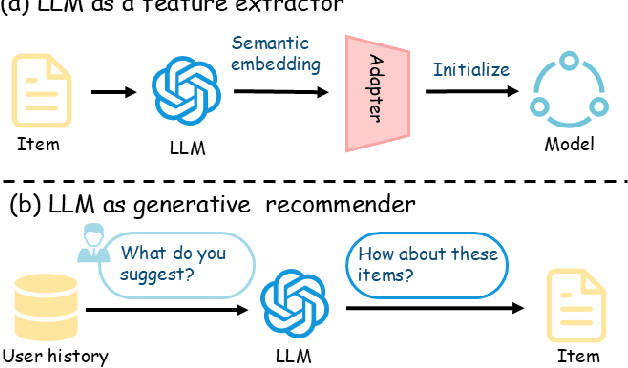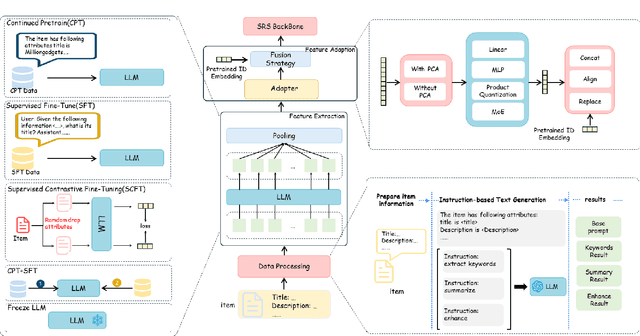Recommendation
Recommendation is the task of providing personalized suggestions to users based on their preferences and behavior.
Papers and Code
VizGen: Data Exploration and Visualization from Natural Language via a Multi-Agent AI Architecture
Sep 26, 2025Data visualization is essential for interpreting complex datasets, yet traditional tools often require technical expertise, limiting accessibility. VizGen is an AI-assisted graph generation system that empowers users to create meaningful visualizations using natural language. Leveraging advanced NLP and LLMs like Claude 3.7 Sonnet and Gemini 2.0 Flash, it translates user queries into SQL and recommends suitable graph types. Built on a multi-agent architecture, VizGen handles SQL generation, graph creation, customization, and insight extraction. Beyond visualization, it analyzes data for patterns, anomalies, and correlations, and enhances user understanding by providing explanations enriched with contextual information gathered from the internet. The system supports real-time interaction with SQL databases and allows conversational graph refinement, making data analysis intuitive and accessible. VizGen democratizes data visualization by bridging the gap between technical complexity and user-friendly design.
Teaching AI to Feel: A Collaborative, Full-Body Exploration of Emotive Communication
Sep 26, 2025Commonaiverse is an interactive installation exploring human emotions through full-body motion tracking and real-time AI feedback. Participants engage in three phases: Teaching, Exploration and the Cosmos Phase, collaboratively expressing and interpreting emotions with the system. The installation integrates MoveNet for precise motion tracking and a multi-recommender AI system to analyze emotional states dynamically, responding with adaptive audiovisual outputs. By shifting from top-down emotion classification to participant-driven, culturally diverse definitions, we highlight new pathways for inclusive, ethical affective computing. We discuss how this collaborative, out-of-the-box approach pushes multimedia research beyond single-user facial analysis toward a more embodied, co-created paradigm of emotional AI. Furthermore, we reflect on how this reimagined framework fosters user agency, reduces bias, and opens avenues for advanced interactive applications.
GoalRank: Group-Relative Optimization for a Large Ranking Model
Sep 26, 2025Mainstream ranking approaches typically follow a Generator-Evaluator two-stage paradigm, where a generator produces candidate lists and an evaluator selects the best one. Recent work has attempted to enhance performance by expanding the number of candidate lists, for example, through multi-generator settings. However, ranking involves selecting a recommendation list from a combinatorially large space. Simply enlarging the candidate set remains ineffective, and performance gains quickly saturate. At the same time, recent advances in large recommendation models have shown that end-to-end one-stage models can achieve promising performance with the expectation of scaling laws. Motivated by this, we revisit ranking from a generator-only one-stage perspective. We theoretically prove that, for any (finite Multi-)Generator-Evaluator model, there always exists a generator-only model that achieves strictly smaller approximation error to the optimal ranking policy, while also enjoying scaling laws as its size increases. Building on this result, we derive an evidence upper bound of the one-stage optimization objective, from which we find that one can leverage a reward model trained on real user feedback to construct a reference policy in a group-relative manner. This reference policy serves as a practical surrogate of the optimal policy, enabling effective training of a large generator-only ranker. Based on these insights, we propose GoalRank, a generator-only ranking framework. Extensive offline experiments on public benchmarks and large-scale online A/B tests demonstrate that GoalRank consistently outperforms state-of-the-art methods.
Building Data-Driven Occupation Taxonomies: A Bottom-Up Multi-Stage Approach via Semantic Clustering and Multi-Agent Collaboration
Sep 19, 2025Creating robust occupation taxonomies, vital for applications ranging from job recommendation to labor market intelligence, is challenging. Manual curation is slow, while existing automated methods are either not adaptive to dynamic regional markets (top-down) or struggle to build coherent hierarchies from noisy data (bottom-up). We introduce CLIMB (CLusterIng-based Multi-agent taxonomy Builder), a framework that fully automates the creation of high-quality, data-driven taxonomies from raw job postings. CLIMB uses global semantic clustering to distill core occupations, then employs a reflection-based multi-agent system to iteratively build a coherent hierarchy. On three diverse, real-world datasets, we show that CLIMB produces taxonomies that are more coherent and scalable than existing methods and successfully capture unique regional characteristics. We release our code and datasets at https://anonymous.4open.science/r/CLIMB.
Understanding Embedding Scaling in Collaborative Filtering
Sep 19, 2025



Scaling recommendation models into large recommendation models has become one of the most widely discussed topics. Recent efforts focus on components beyond the scaling embedding dimension, as it is believed that scaling embedding may lead to performance degradation. Although there have been some initial observations on embedding, the root cause of their non-scalability remains unclear. Moreover, whether performance degradation occurs across different types of models and datasets is still an unexplored area. Regarding the effect of embedding dimensions on performance, we conduct large-scale experiments across 10 datasets with varying sparsity levels and scales, using 4 representative classical architectures. We surprisingly observe two novel phenomenon: double-peak and logarithmic. For the former, as the embedding dimension increases, performance first improves, then declines, rises again, and eventually drops. For the latter, it exhibits a perfect logarithmic curve. Our contributions are threefold. First, we discover two novel phenomena when scaling collaborative filtering models. Second, we gain an understanding of the underlying causes of the double-peak phenomenon. Lastly, we theoretically analyze the noise robustness of collaborative filtering models, with results matching empirical observations.
What Matters in LLM-Based Feature Extractor for Recommender? A Systematic Analysis of Prompts, Models, and Adaptation
Sep 18, 2025



Using Large Language Models (LLMs) to generate semantic features has been demonstrated as a powerful paradigm for enhancing Sequential Recommender Systems (SRS). This typically involves three stages: processing item text, extracting features with LLMs, and adapting them for downstream models. However, existing methods vary widely in prompting, architecture, and adaptation strategies, making it difficult to fairly compare design choices and identify what truly drives performance. In this work, we propose RecXplore, a modular analytical framework that decomposes the LLM-as-feature-extractor pipeline into four modules: data processing, semantic feature extraction, feature adaptation, and sequential modeling. Instead of proposing new techniques, RecXplore revisits and organizes established methods, enabling systematic exploration of each module in isolation. Experiments on four public datasets show that simply combining the best designs from existing techniques without exhaustive search yields up to 18.7% relative improvement in NDCG@5 and 12.7% in HR@5 over strong baselines. These results underscore the utility of modular benchmarking for identifying effective design patterns and promoting standardized research in LLM-enhanced recommendation.
MapAnything: Mapping Urban Assets using Single Street-View Images
Sep 18, 2025To maintain an overview of urban conditions, city administrations manage databases of objects like traffic signs and trees, complete with their geocoordinates. Incidents such as graffiti or road damage are also relevant. As digitization increases, so does the need for more data and up-to-date databases, requiring significant manual effort. This paper introduces MapAnything, a module that automatically determines the geocoordinates of objects using individual images. Utilizing advanced Metric Depth Estimation models, MapAnything calculates geocoordinates based on the object's distance from the camera, geometric principles, and camera specifications. We detail and validate the module, providing recommendations for automating urban object and incident mapping. Our evaluation measures the accuracy of estimated distances against LiDAR point clouds in urban environments, analyzing performance across distance intervals and semantic areas like roads and vegetation. The module's effectiveness is demonstrated through practical use cases involving traffic signs and road damage.
Diagnostics of cognitive failures in multi-agent expert systems using dynamic evaluation protocols and subsequent mutation of the processing context
Sep 18, 2025



The rapid evolution of neural architectures - from multilayer perceptrons to large-scale Transformer-based models - has enabled language models (LLMs) to exhibit emergent agentic behaviours when equipped with memory, planning, and external tool use. However, their inherent stochasticity and multi-step decision processes render classical evaluation methods inadequate for diagnosing agentic performance. This work introduces a diagnostic framework for expert systems that not only evaluates but also facilitates the transfer of expert behaviour into LLM-powered agents. The framework integrates (i) curated golden datasets of expert annotations, (ii) silver datasets generated through controlled behavioural mutation, and (iii) an LLM-based Agent Judge that scores and prescribes targeted improvements. These prescriptions are embedded into a vectorized recommendation map, allowing expert interventions to propagate as reusable improvement trajectories across multiple system instances. We demonstrate the framework on a multi-agent recruiter-assistant system, showing that it uncovers latent cognitive failures - such as biased phrasing, extraction drift, and tool misrouting - while simultaneously steering agents toward expert-level reasoning and style. The results establish a foundation for standardized, reproducible expert behaviour transfer in stochastic, tool-augmented LLM agents, moving beyond static evaluation to active expert system refinement.
Mind the Gap: A Closer Look at Tokenization for Multiple-Choice Question Answering with LLMs
Sep 18, 2025When evaluating large language models (LLMs) with multiple-choice question answering (MCQA), it is common to end the prompt with the string "Answer:" to facilitate automated answer extraction via next-token probabilities. However, there is no consensus on how to tokenize the space following the colon, often overlooked as a trivial choice. In this paper, we uncover accuracy differences of up to 11% due to this (seemingly irrelevant) tokenization variation as well as reshuffled model rankings, raising concerns about the reliability of LLM comparisons in prior work. Surprisingly, we are able to recommend one specific strategy -- tokenizing the space together with the answer letter -- as we observe consistent and statistically significant performance improvements. Additionally, it improves model calibration, enhancing the reliability of the model's confidence estimates. Our findings underscore the importance of careful evaluation design and highlight the need for standardized, transparent evaluation protocols to ensure reliable and comparable results.
Set Contribution Functions for Quantitative Bipolar Argumentation and their Principles
Sep 18, 2025We present functions that quantify the contribution of a set of arguments in quantitative bipolar argumentation graphs to (the final strength of) an argument of interest, a so-called topic. Our set contribution functions are generalizations of existing functions that quantify the contribution of a single contributing argument to a topic. Accordingly, we generalize existing contribution function principles for set contribution functions and provide a corresponding principle-based analysis. We introduce new principles specific to set-based functions that focus on properties pertaining to the interaction of arguments within a set. Finally, we sketch how the principles play out across different set contribution functions given a recommendation system application scenario.
 Add to Chrome
Add to Chrome Add to Firefox
Add to Firefox Add to Edge
Add to Edge